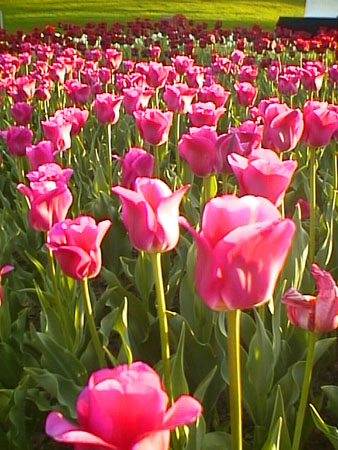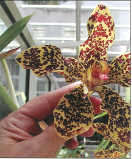Saturday, October 31, 2009
New Blog Spot
It's been 2 whole months since Royal Design Flowers & Events last blogged. Been crazy busy and Sick..................
Well I'm moving the blog to my website. So from now on, check me out here ---------->
http://www.royaldesignflowers.com/portfolio.html
Thanks!
Necoh :)
Thursday, August 20, 2009
Blue and White





Thursday, August 6, 2009
Bouquet Choices
There aren't hundreds of bouquet styles, but there may be more out there than ya think.
Most are familiar with 3 types: Hand-tied(stems showing), cascade, and "round." I have lots of brides who want "round." There is a techie term, but I shall get to that later.
I thought I'd give a little insight into the options....One at a time.
First I'll list them, then I'll launch into #1. K? OK.
The typical types are:
- Cascade
- Beidermeier
- Hand-Tied
- Arm/Pageant
- Posy
- Nosegay/Tussie-Mussie
- Composite
- Free-form
There are other categories that are "out there," but these are generally the range of bouquets.
So on to the explainin'.
#1 The Cascade Bouquet.
These bouquets are described as a falling or
 tumbling effect of flowers. Or a waterfall. Get it? I think you do.
tumbling effect of flowers. Or a waterfall. Get it? I think you do.Cascade bouquets are generally very traditional. But with different flowers, they can be very modern. Imagine using tropical flowers, like Bird of Paradise and Heliconia to create a striking, non traditional bouquet.
Cascade bouquets are created by inserting stems and greenery into a bouquet holder. They are very nice because the holder has watered floral foam , and your bouquet can last for quite some time without having to be "put in water."
You can use pretty much any kind of flower for this particular bouquet type. That's the fun of it. Choose your colors, flower type, and your personal style, and with this classic bouquet, you'll always win.Friday, July 31, 2009
Trends in Wedding Flowers
- COLOR
Gone are the days of the traditional bridal bouquet in all pure, pristine white. Not saying you  can't have that, or even love that, but most brides I have been working with want color. I recently had one who had me add white, to please her mother. The really sweet mother(really she is) just didn't think her daughter's tropical, colorful bouquet looked "bridal" without white. And in general, this is the norm. Brides want saturated hues, not only for the bridesmaids, but for their bouquets as well. I say, if nature gives us the beauty that is plum, ruby red, and tangerine orange, go for it!
can't have that, or even love that, but most brides I have been working with want color. I recently had one who had me add white, to please her mother. The really sweet mother(really she is) just didn't think her daughter's tropical, colorful bouquet looked "bridal" without white. And in general, this is the norm. Brides want saturated hues, not only for the bridesmaids, but for their bouquets as well. I say, if nature gives us the beauty that is plum, ruby red, and tangerine orange, go for it!
2. Texture

Tuesday, July 28, 2009
The Baltimore Aquarium
 Purple Oncidium orchid. So gorgeous!
Purple Oncidium orchid. So gorgeous!
 Purple Cattleya orchid
Purple Cattleya orchid The dolphins!!!!! Yea! They were so beautiful, I was brought to tears. One day I WILL swim with them.......
The dolphins!!!!! Yea! They were so beautiful, I was brought to tears. One day I WILL swim with them.......
Life is good...............................
Flower of the Week (More like of the Month)

I have a slight love affair with this gentle creature. It borders on the "rose" in appearance, but is much more dainty. This double flowered pretty comes in my favorite shades; blues, purples, pinks and greens.
 Lisianthus is a beautiful addition to your wedding bouquet or centerpiece.
Lisianthus is a beautiful addition to your wedding bouquet or centerpiece.photo courtesy Brides.com
Just remember that this "Prairie Gentian" or "Eustoma" must have flower food. It is very delicate, but can last for a week if properly kept.

Saturday, July 4, 2009
Goodbye :(

 Love you!
Love you!Friday, July 3, 2009
Candice's Crystal Trees

Pictures of her wedding flowers to come............................................................
State Flowers: Maryland
Ok, so the Maryland State Flower is the Black-Eyed Susan.
Facts for "Miss Susan."
- She became the Maryland state flower in 1918.
- The Black-Eyed Susan is probably the most common of all American wildflowers. The characteristic brown, domed center is surrounded by bright yellow ray florets.
- The roots can be used as an astringent in a warm infusion as a wash for sores and swellings.
- Juice from the roots had been used as drops for earaches.
- The flower is thought to be native all the way from the plains to the Atlantic coast in the mid-Atlantic states. Very prolific!
- If you want to grow them, they are one of the very easiest wildflowers to grow. Simply compress the seed into bare soil during spring, summer or fall.
- When cut, the Black-Eyed Susan has a vase life of 6 to 10 days. ooooooh nice!

Wednesday, July 1, 2009
Flower of the Week
 When thinking of tulips, most people assume they originated in Holland, but both the flower and its name originated in the Persian empire. The tulip, or lale as it is also called in Turkey, is a flower indigenous to Turkey, Iran, Afghanistan and other parts of Central Asia. It's not known who first brought the flower to northwest Europe, but it's the Turks who made tulip known in Europe. The tulip originated over ten decades ago in Persia and Turkey, where it played a significant role in the art and culture of the time. Most likely commenting on the Turkish tradition of wearing tulips in one’s turban, Europeans mistakenly gave tulips their name, which comes from the Persian word meaning turban. As Europeans began taking to tulips, the flower’s popularity spread quickly, particularly in the Netherlands where a phenomenon called "tulip mania" set in between 1634 and 1637. Tulip bulbs were even a form of currency. Tulips became so highly-prized that prices went sky-high and markets crashed. "Wow", you think, "all that for a flower?" :)
When thinking of tulips, most people assume they originated in Holland, but both the flower and its name originated in the Persian empire. The tulip, or lale as it is also called in Turkey, is a flower indigenous to Turkey, Iran, Afghanistan and other parts of Central Asia. It's not known who first brought the flower to northwest Europe, but it's the Turks who made tulip known in Europe. The tulip originated over ten decades ago in Persia and Turkey, where it played a significant role in the art and culture of the time. Most likely commenting on the Turkish tradition of wearing tulips in one’s turban, Europeans mistakenly gave tulips their name, which comes from the Persian word meaning turban. As Europeans began taking to tulips, the flower’s popularity spread quickly, particularly in the Netherlands where a phenomenon called "tulip mania" set in between 1634 and 1637. Tulip bulbs were even a form of currency. Tulips became so highly-prized that prices went sky-high and markets crashed. "Wow", you think, "all that for a flower?" :)Tulips are now grown throughout the world, but people still identify cultivated varieties as "Dutch tulips."
Tulips do best in climates with long cool springs and early summers, but they are often grown as spring blooming annual plantings in warmer areas of the world. The bulbs are typically planted in late summer and fall.
They are generally only available as cut flowers for weddings in springtime, but I found a grower in California who has them year round! Just a little note for you tulip lovin' brides-to-be.....

"The director needs these flowers tonight!"
Here's an excerpt of the conversation:
"I need some flowers sent to an actress who's on set right now."
"I really only work on weddings, I'm not actually a flower shop." (I'm crazy right?)
"Ok, do you know anyone who can help us?"
"So and So Flower Shop."
"ok................"
So I call back, thinking, no one can help this lady at this late time.....
"Did you find anyone to help you?"
"No, I didn't"
"I can probably work up something for you."
"Thank you so much! What can you make?"
"Well, I do have hot pink hydrangeas on hand."
"Let me call the director and ask him if that's ok."

Well, I guess they were :)
Hope the "well known actress named "Kerry" was pleased!!!!!
Thursday, June 11, 2009
State Flowers: Minnesota

Interesting facts about the "Showy Lady's Slipper"
- "She" was adopted as the state flower in 1902.
- Lady's Slippers grow slowly, taking up to 16 years to produce their first flowers. Talk about taking your own sweet time!
- They can live for up to 50 years and grow up to four feet tall.
- She is rare and thus protected by state law. It is illegal to pick the flowers or to uproot.
- She typically flowers in late June and early July, with generally 1 or 2 flowers per stem.
I've never had the pleasure of seeing her in person. Maybe one day on a trip back home, I'll be wandering the swamps and bogs and stumble upon this beauty.. (Ok, so I don't traverse swamps and bogs, but it sounded kinda good...)
Bye for now, gee gosh dontcha know....
Saturday, June 6, 2009
Flower of the Week: Orchid
Well, did you know that the biggest orchid , the Tiger orchid, is so huge that it weighs about 2,000 pounds?!?!?! Now with the average Cymbidium orchid being about 100 do
 llars a stem, WHAT would that cost? Ha, can you imagine even trying to finagle that one? silly :)
llars a stem, WHAT would that cost? Ha, can you imagine even trying to finagle that one? silly :)Did ya know?
- Orchids have the largest variety of flowering plants with about 20,000 natural species
- Orchids grow everywhere, except, Antarctica. There are some that grow in the Artic Circle. Imagine that!!!
- Vanilla is in the Orchid family.
- African Orchids are white, while Asian orchids are often multicolored.
- Orchids are abundant in the tropics, where the majority of the species grow on the trunks and branches of trees. In temperate zones, like southern Australia, most Orchids grow on the ground.
Just a few facts about the fabulous Orchid.
Sunday, May 31, 2009
Flower Fedora
The main part of the hat is mini white carnations. They and button mums are best for sculptural work. The red is mini carns as well. The green band is made of individual Nagi leaves that I glued together.
Here are a few pictures of the process:
Beginning to carve out the basic shape.
The finished left side of the hat.
The front of the hat.
Whaddya think?




















